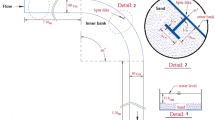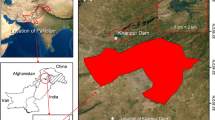Abstract
The flow field around spur dike group is complex, noticeable, and widely encountered in the improving progress of urban riverways and coastlines. Detailed investigation on such flow phenomenon is necessary and of applied significance. In contrast to experimental study and field survey, the numerical simulation can provide much more details with relative low cost. Aiming to identify the appropriate Computational Fluid Dynamics (CFD) models for simulating flow around spur dike group, the flow fields around non-submerged and submerged spur dike groups, including eight spur dikes in staggered arrangement, were numerically investigated in this paper with selected CFD models and validated based on corresponding flume test, i.e., two sets of laboratory experiments and observed data collected. The numerical simulations were carried out using Finite Volume Method (FVM) and three turbulence models, i.e., standard k-ε model, Reynolds Stress Model (RSM) and Large Eddy Simulation (LES) model. In each model, the free surface boundary was implemented respectively via two approaches, i.e., rigid-lid assumption (RLA) and volume of fluid (VOF) method. The comparisons between the CFD outputs and the observed data from flume experiments show that all three turbulence models are capable to simulate the three-dimensional flow around spur dike group to certain degree. It is noticed that, with comprehensive understanding of simulation accuracy and computational time, aiming to rapidly capture the field characteristics of main flow for non-submerged spur dike group, the standard k-ε model under RLA method is recommended, while to achieve the fine simulation of spur dike field especially in backflow zone, LES model under VOF method is appropriate. For submerged spur dike group, comparing to simulation accuracy, simulation cost is not a major factor concerned and LES model based on VOF method is the most suitable one due to the overflow effect of spur dike crest and the backwater effect of spur dike body.










Similar content being viewed by others
References
Acharya A, Duan JG (2011) Three dimensional simulation of flow field around series of spur dikes. Proc. World Environmental and Water Resources Congress 2011:2085–2094. doi:10.1061/41173(414)218
Azinfar H, Kells JA (2008) Backwater prediction due to the blockage caused by a single, submerged spur dike in an open channel. J Hydraul Eng 134:1153–1157. doi:10.1061/(ASCE)0733-9429(2008)134:8(1153)
Chau KW, Wu CL (2010) A Hybrid Model Coupled with Singular Spectrum Analysis for Daily Rainfall Prediction. J Hydroinf 12(4):458–473
Cui ZF, Zhang XF (2006) Flow simulation of spur dike using 3-D turbulent model. Engineering Journal of Wuhan University 39(1):15–20. doi:10.3969/j.issn.1671-8844.2006.01.004
Duan J, He L, Fu XD, Wang GQ (2009) Mean flow and turbulence around experimental spur dike. Adv Water Resour 32:1717–1725. doi:10.1016/j.advwatres.2009.09.004
Duan J, He L, Wang GQ, Fu XD (2011) Turbulent burst around experimental spur dike. International Journal of Sediment Research 26:471–486. doi:10.1016/S1001–6279(12)60006–7
Ferziger JH, Perić M (2002) Computational methods for fluid dynamics. Springer-Verlag Berlin Heidelberg, New York, USA doi:10.1007/978–3–642–56026–2
Galvan S, Reggio M, Guibault F (2011) Assessment study of k-epsilon turbulence models and near-wall modeling for state swirling flow analysis in draft tube using FLUENT. Engineering Applications of Computational Fluid Mechanics 5(4):459–478. doi:10.1080/19942060.2011.11015386
Han SS, Biron PM, Ramamurthy AS (2011) Three-dimensional modelling of flow in sharp open-channel bends with vanes. J Hydraul Res 49(1):64–72. doi:10.1080/00221686.2010.534275
Ishihara T, Gotoh T, Kaneda Y (2009) Study of high-Reynolds number isotropic turbulence by direct numerical simulation. Annu Rev Fluid Mech 41:165–180. doi:10.1146/annurev.fluid.010908.165203
Kalita HM, Sarma AK, Bhattacharjya RK (2014) Evaluation of optimal river training work using GA based linked simulation-optimization approach. Water Resour Manag 28(8):2077–2092. doi:10.1007/s11269–014–0593–3
Kuhnle RA, Jia Y, Alonso CV (2008) Measured and simulated flow near a submerged spur dike. J Hydraul Eng 134(7):916–924. doi:10.1061/(ASCE)0733-9429(2008)134:7(916)
Le H, Moin P, Kim J (1997) Direct numerical simulation of turbulent flow over a backward-facing step. J Fluid Mech 330:49–374. doi:10.1017/S0022112096003941
Li ZQ, Li H, Li J, Li R (2003) Experimental study and numerical simulation of flow in the vicinity of a submerged spur-dike. J Hydraul Eng 8:53–57. doi:10.3321/j.issn:0559–9350.2003.08.011
Liu YN, Guo XY, Wang BL, Liu Y (2007) Numerical simulation of wave overtopping over seawalls using the RANS equations. J Hydrodyn (A) 22(6):682–688. doi:10.3969/j.issn.1000–4874.2007.06.003
Mayerle R, Wang SSY, Toro M (1995) Verification of a three-dimensional numerical model simulation of the flow in the vicinity of spur dikes. J Hydraul Res 33(2):243–256. doi:10.1080/00221689509498673
McAnally W, Letter J, Phillip Stewart J, Anthony Thomas W, James Brogdon N (1984) Columbia River hybrid modeling system. J Hydraul Eng 110(3):300–311. doi:10.1061/(ASCE)0733-9429(1984)110:3(300)
Moin P, Mahesh K (1998) Direct numerical simulation: a tool in turbulence research. Annu Rev Fluid Mech 30:539–578. doi:10.1146/annurev.fluid.30.1.539
Molls T, Chaudhry MH, Khan KW (1995) Numerical simulation of two-dimensional flow near a spur-dike. Adv Water Resour 18(4):227–236. doi:10.1016/0309–1708(95)00010-G
Patanka SV (1980) Number simulation of the heat transfer and fluid flow. McGraw-Hill Book Company, Hemisphere Publishing Corp., New York, USA
Peng J, Nobuyuki T, Yoshihisa K (2002) Numerical modeling of local scour around spur dikes. J Sediment Res 1:25–29. doi:10.3321/j.issn:0468-155X.2002.01.004
Qi P, Sun ZY, Peng H (2010) Comparison on the improvement plans of mobile channel in lower Yellow River. http://www.hwcc.gov.cn/pub/hwcc/wwgj/bgqy/201002/t20100201_313467.html
Schmidt S, Thiele F (2003) Detached eddy simulation of flow around A-airfoil. Flow, Turbulence and Combustion 71(1–4):261–278. doi:10.1023/B:APPL.0000014933.66058.22
Tang XL, Ding X, Chen ZC (2006) Large eddy simulations of three-dimensional flows around a spur dike. Tsinghua Sci Technol 11(1):117–123. doi:10.1016/S1007–0214(06)70164-X
Tang XL, Ding X, Chen ZC (2007) Experimental and numerical investigations on secondary flows and sedimentations behind a spur dike. J Hydrodyn 19(1):23–29. doi:10.1016/S1001–6058(07)60023–7
Taormina R, Chau KW (2015) Data-driven input variable selection for rainfall-runoff modeling using binary-coded particle swarm optimization and Extreme Learning Machines. J Hydrol 529(3):1617–1632
Wang WC, Chau KW, Xu DM, Chen XY (2015) Improving forecasting accuracy of annual runoff time series using ARIMA based on EEMD decomposition. Water Resour Manag 29(8):2655–2675. doi:10.1007/s11269–015–0962–6
Yang JW, Xu ZH, Teng LJ (2008) Numerical simulation research of turbulent flows based on software FLUENT in open channel with small scale. Yangtze River 39(19):76–80. doi:10.3969/j.issn.1001–4179.2008.19.026
Yu SB, Han YF (2011) The interaction of spur dike, flow and bed. Yellow River Conservancy Press, Zhengzhou, China
Acknowledgments
The contents of the paper were partially supported by Strategic research grant, City University of Hong Kong [Projects No. CityU-SRG 7004360], National Natural Science Foundation of China (Grant No. 51579216), Science and Technology Project of DWRZJ (Grant No. RC1106) & Science and Technology Project of Jinhua City (Grant No. 2013-3-027).
Author information
Authors and Affiliations
Corresponding author
Rights and permissions
About this article
Cite this article
Gu, Z., Cao, X., Jiao, Y. et al. Appropriate CFD Models for Simulating Flow around Spur Dike Group along Urban Riverways. Water Resour Manage 30, 4559–4570 (2016). https://doi.org/10.1007/s11269-016-1436-1
Received:
Accepted:
Published:
Issue Date:
DOI: https://doi.org/10.1007/s11269-016-1436-1




